The thought coming into the season was that the Colorado Rockies were going to be one of the worst teams in the league. The spotlight was on them, but for the wrong reasons, after a chaotic offseason in which they traded their franchise player and the dysfunction in the team was brought to the forefront. A lot of the talk was about what was happening off the field rather than on it. Not much spotlight was given to the players who were actually suiting up for the team night in and night out and playing the 162 games this year.
There wasn’t much spotlight or hype on Ryan McMahon in particular. McMahon is a player who at one point had many people excited and hyped up about his future, and for obvious reasons—McMahon was a one-time top-100 prospect who gets to play the majority of his games in Colorado. There was a good reason for that lack of hype though, as McMahon struggled big time in the shortened 2020 season. After seemingly taking some steps forward at the plate in 2019 in which he hit 24 home runs, McMahon regressed in pretty much every way last year, with a .215/.295/.419 slash line, which translates to a paltry 76 wRC+ when adjusted to the ballpark. The allure of Colorado wasn’t going to be enough to get a hype train going on McMahon coming into this year, and it wasn’t all that clear that there was much there for McMahon. Many thought he might just end up being another disappointing Rockies hitter, which has become a theme in recent years.
Fast forward to this season, though, and McMahon is quietly changing that narrative. He’s gotten off to a fine start this season, with a .262/.307/.492 triple slash and is currently one of the team’s biggest offensive threats. He looks like a different hitter at the plate this season, and those changes are starting to pay off big time for him.
What makes McMahon different this year has less to do with how he’s hitting the ball, though. McMahon has generally hit the ball well going back to his first run of extended playing time back in 2018. It has never been much of an issue for McMahon, as even in his down 2020 season, his hard-hit rate was still in the 70th percentile of all hitters. Rather, McMahon’s elevated strikeout rate was one of his biggest flaws at the plate, and in 2020, his strikeout rate spiked to a new high:
| Season | Hard-Hit% | K% |
|---|---|---|
| 2018 | 44.1 | 31.7 |
| 2019 | 48.0 | 29.7 |
| 2020 | 43.0 | 34.2 |
Curiously though, that bump in strikeout rate didn’t come along with more whiffs or chases on a rate basis. In fact, both rates were right in line with where they have been in his other two seasons:
| Season | K% | Whiff% | Chase% |
|---|---|---|---|
| 2018 | 31.7 | 33.4 | 31.6 |
| 2019 | 29.7 | 32.4 | 26.5 |
| 2020 | 34.2 | 31.4 | 27.2 |
It does seem odd. A higher rate of whiffs and chases would be an easy explanation for his increased rate of strikeouts, and while based on those rates of whiffs and chases, McMahon is a hitter that would have a higher strikeout rate, those rates don’t exactly suggest a reason for McMahon’s elevated strikeout rate in 2020. Instead, it looks like some of those extra strikeouts can be attributed to an issue with his approach at the plate.
Looking at some of McMahon’s plate discipline metrics, it looks like a few things happened that led to him being a little too passive at the plate. He swung a little bit less but at just a two percent difference—not a substantial amount. What did change in a big way, though, was his rate of swinging at pitches in the strike zone as well as on first pitches, both of which declined sharply from his rates from earlier in his career:
| Season | Swing% | Zone Swing% | First Pitch Swing% |
|---|---|---|---|
| 2018 | 51.8 | 70.9 | 45.5 |
| 2019 | 49.6 | 74.6 | 41.6 |
| 2020 | 47.3 | 67.7 | 28.5 |
So, McMahon was swinging less at pitches in the zone and drastically less on first pitches. In turn, because he was more passive on pitches that are, generally, better pitches to hit, it obviously led to a higher rate of called strikes, all while seeing more pitches in the zone to boot:
| Season | Zone% | Called Strike% |
|---|---|---|
| 2018 | 52.7 | 13.9 |
| 2019 | 48.0 | 11.9 |
| 2020 | 49.7 | 16.1 |
What that then leads to is fewer favorable counts and working from behind more in an at-bat. McMahon suddenly turning a bit more passive on pitches in the zone did not appear to be a good strategy for him. He was falling behind in counts and otherwise taking pitches he could hit hard.
So far this year, though, McMahon has done things a bit differently, and it seems to be working for him in a big way. He’s still showing excellent hard-hit ability, as is standard for him, but now with a better approach. To start, he’s being more aggressive at the plate. Although his overall swing rate is higher this season, it’s not by an outlandishly higher rate (50.4% compared to 47.3% in 2020), and it is still not the highest swing rate of his career. Instead, the added aggression has come on pitches in the strike zone, as he is swinging at those pitches at a higher rate than ever and at a substantial increase from 2020. Additionally, as quite the contrast from 2020, McMahon is not being as passive on first pitches and has reverted back to a rate that is right in line with his career numbers:
| Season | Swing% | Zone Swing% | First Pitch Swing% |
|---|---|---|---|
| 2020 | 47.3 | 67.7 | 28.5 |
| 2021 | 50.4 | 75.0 | 42.1 |
What’s most encouraging, though, is that this level of increased aggressiveness hasn’t corresponded with more whiffs or chases:
| Season | Whiff% | Chase% |
|---|---|---|
| 2020 | 31.4 | 27.2 |
| 2021 | 30.5 | 24.2 |
To go along with that, even with those extra swings, McMahon is still making a similar amount of contact on pitches in the zone (78.9% this year compared to 77.4% last year). Fewer chases and whiffs in conjunction with him maintaining a similar rate of zone contact is a good explanation for his lowered strikeout rate this season. So far this year, McMahon’s strikeout rate is down big time from his previous 30%+ marks, down to a much more reasonable 22.9%—one of the largest strikeout rate increases at this point in the season:
| Player | K% 2021 | K% 2020 | Difference |
|---|---|---|---|
| Omar Narvaez | 12.7 | 31.0 | -18.3 |
| Ronald Acuna Jr. | 13.5 | 29.7 | -16.2 |
| Evan White | 29.2 | 41.6 | -12.4 |
| Gary Sanchez | 24.4 | 36.0 | -11.6 |
| Ryan McMahon | 22.9 | 34.2 | -11.3 |
Fewer strikeouts is clearly a good thing, but even more so for McMahon due to his great ability to hit the ball hard, which has reverted back to right around his outstanding 2019 rate at 48.5%.
Now, it is certainly possible that some of this could have more to do with the circumstances surrounding the Rockies as a team this season. From an opponent’s point of view, the game plan could have entailed them to just go right after it and attack Rockies hitters not named Trevor Story or Charlie Blackmon in the zone to start the year. They could have just let him try and make good contact and not waste as many pitches, as pitchers may pitch differently depending on who the hitter is, and the Rockies didn’t have many bats that would likely cause immediate panic when evaluating their lineup at the beginning of the year. Based on his weak 2020 season, McMahon could have very well been included in that group. The reason why that is a potential theory is due to the fact that McMahon was seeing a lot more pitches in the zone at the very beginning of the season, which has come back down to earth in the following weeks, once McMahon started making pitchers pay for it:

It’s spiked a bit recently, but it seems like once pitchers realized that McMahon was more than capable of punishing mistakes inside the zone, they stopped giving him as many pitches in the zone, and perhaps shifting their plan of attack again, and giving him more pitches out of the zone to see if he would go back to his chase-heavy ways. So far, though when pitchers have tried this, McMahon has done a good job of holding up and not giving in, with his chase rate continuing to trend down:
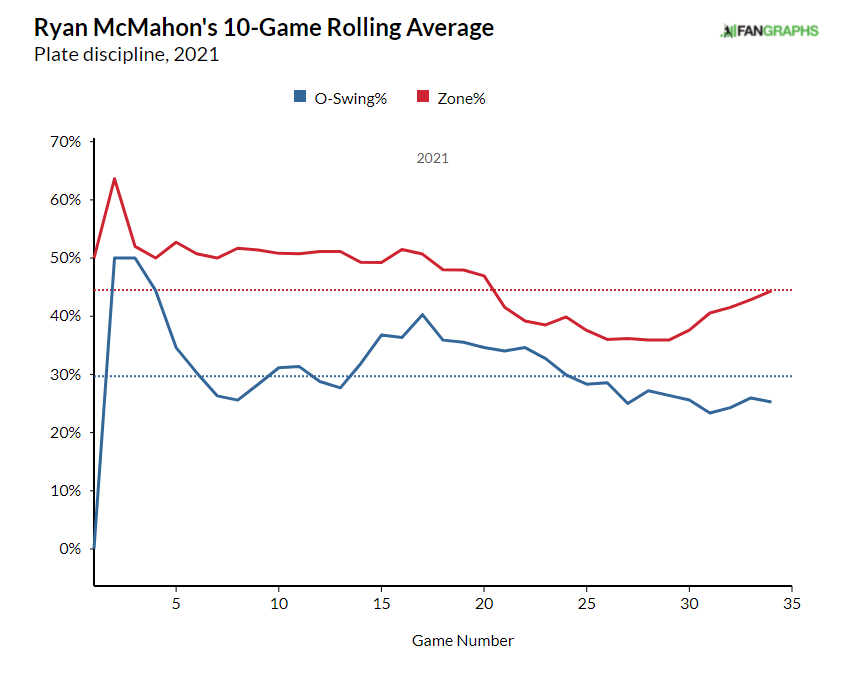
All the while, even as he continues to be pitched differently, McMahon is sticking with his approach of being aggressive when he gets a pitch in the zone, as his zone swing rate has pretty much held constant throughout the season:
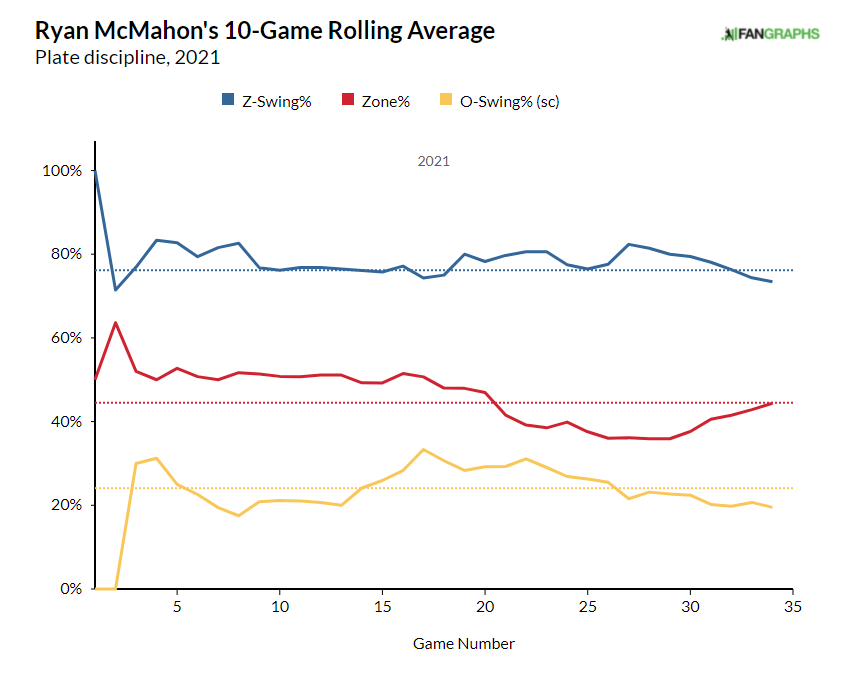
It is a bit rare to see that, as it is common to see more swings and aggressiveness resulting in more chases, but in general, McMahon is doing a good job of laying off pitches out of the zone all while continuing to attack pitches in the zone—especially in a certain spot:
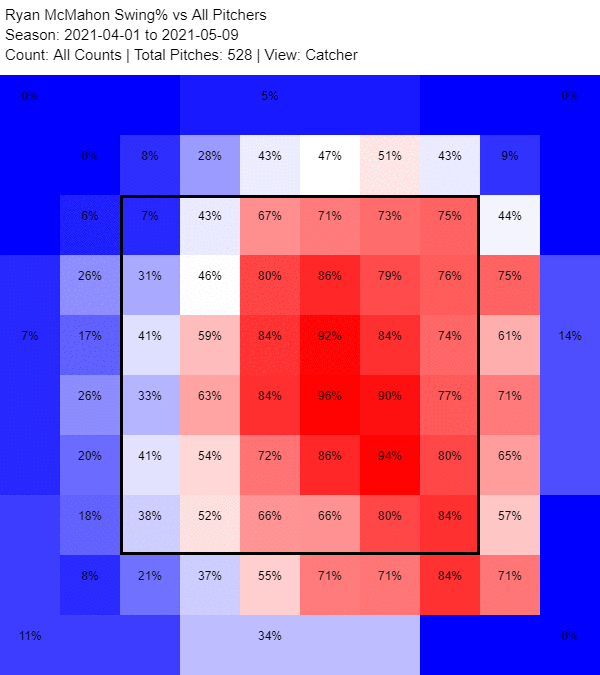
While McMahon’s swing rates are up pretty much everywhere in each of the strike zone, it looks like he’s even more so hunting out pitches in the middle and inside portion of the plate. It seems as if McMahon is quite fond of pitches in that spot, as that is already the area where he swung most frequently in his entire career:

This makes sense considering that this area is the place where he has gotten the best results in terms of isolated power both in his career, as well as this season:
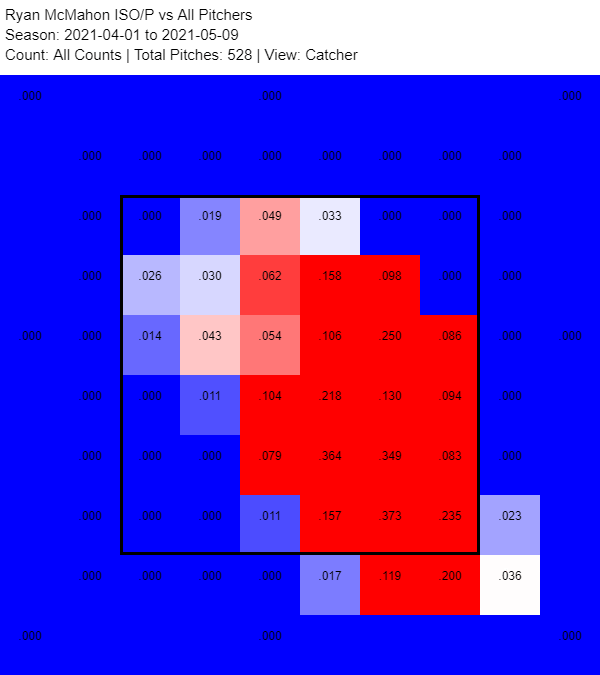
The main difference appears to be just how much more damage McMahon is doing this season in those areas, but overall, this looks to match up with the rest of his career. So, it seems like the extra aggression he’s been displaying is coming on pitches that he already knows he can do some good damage to. It’s as if McMahon is doubling down more so on the pitches that he already likes. That seems like a fine idea, and doing so without expanding the zone more is just the cherry on top.
And that’s all before we get more into his batted-ball improvements. While the focus has mostly been on his approach at the plate to this point, things are also happening differently when he actually hits the ball. Along with the strikeouts, another big area of weakness for McMahon has been that he puts too many balls on the ground, which is even more frustrating considering, you know, Colorado and all that. This year though, McMahon has been hitting the ball a lot more optimally, and it has been a night and day difference when it comes to his groundball rate:
| Player | GB% 2021 | GB% 2020 | Difference |
|---|---|---|---|
| Stephen Piscotty | 28.3 | 46.3 | -18.0 |
| Evan Longoria | 33.8 | 50.3 | -16.5 |
| Kevin Pillar | 24.4 | 40.7 | -16.3 |
| Ryan McMahon | 34.3 | 50.5 | -16.2 |
| Kyle Schwarber | 35.6 | 51.2 | -15.6 |
Looking at launch angle also shows this, as his average launch angle has essentially doubled from last year up to 18 degrees, which is by far the highest of his career. He’s also one of the top-ten largest improvers in that department year-to-year, which is a plus. McMahon is also spraying the ball a lot more this year. While he’s never been an overly extreme pull-hitter, he still has had some extreme changes here, as his pull rate last season was the highest of his career at 38.3%, and that is now down to 27.3% this season. That, in addition to fewer groundballs, should help his batting average play up some. While his current .262 average is nothing to get too excited about, it’s not overly BABIP fueled, as his BABIP stands at just .286, and Statcast may even suggest that McMahon has been a little unlucky here, with an expected average of .282. However, that doesn’t mean his power will suffer, as most of his home runs are still going to the pull-side, where they would be expected to go:
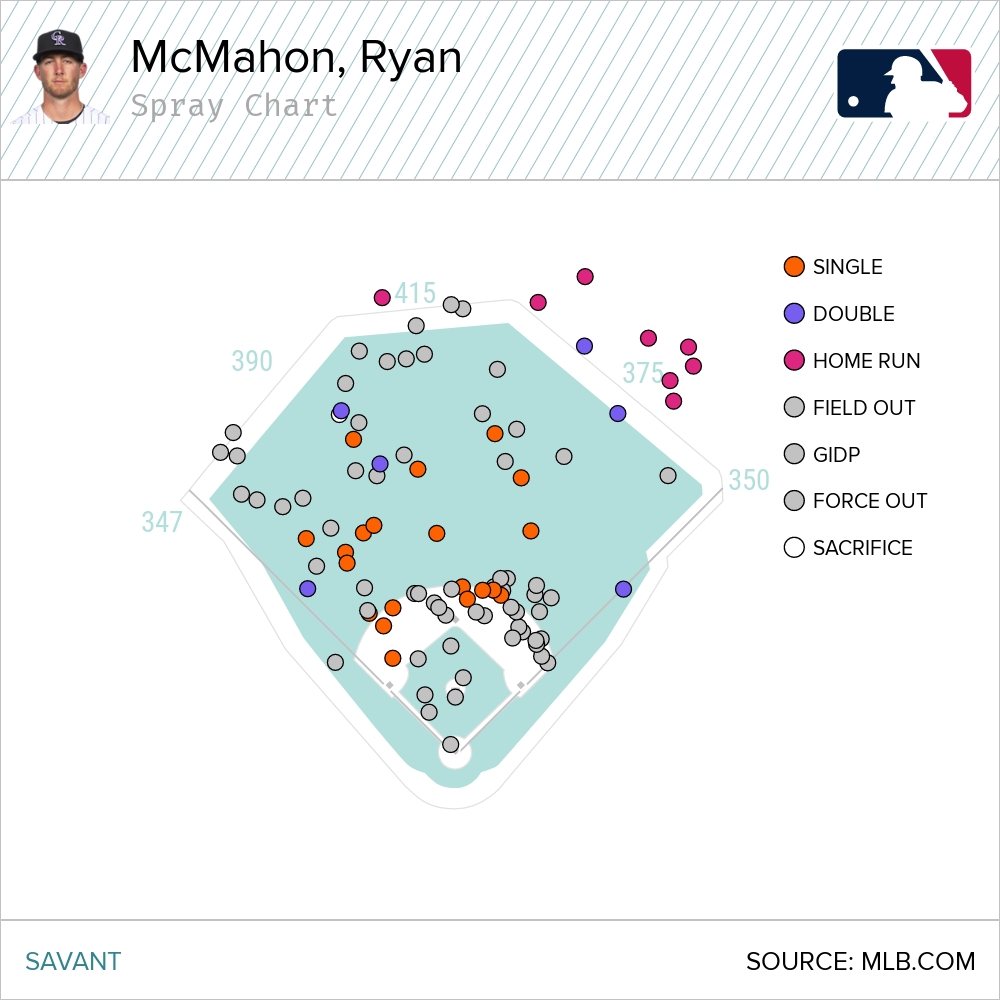
Overall, McMahon simply just looks like a better all-around hitter this season. In the past, his main attraction at the plate was that he had good power in a favorable home ballpark, but that was pretty much it. He was going to strike out, and he was going to hit balls on the ground, and it just looked to be a part of who he was. Things were more extreme in 2020, but now finally, with locked-in everyday playing time this season and some adjustments, McMahon has had the opportunity to show what he can do, and the early returns look quite good. This is a profile that would play anywhere; it happening in Colorado just makes it that much better. Due to some adjustments having to do with his approach, along with getting fewer balls on the ground, spraying the ball more, and continuing to hit the ball hard, McMahon is playing some of the best baseball of his career. After coming into the season without little fanfare or hype, McMahon is solidly on the radar, and if these adjustments hold, should be there to stay.
Photo by Dustin Bradford/Icon Sportswire | Adapted by Doug Carlin (@Bdougals on Twitter)


2020 data really should not carry much weight if any. McMahon played almost every day pretty well the last time they played real baseball. Furthermore a sophomore slump is super common. For whatever reasons there was not a ton of hype but this all seems well within the range of reasonable to me. He is currently right around average which seems like exactly what he is. The concerning thing is that his numbers are floated by a fluke start to the season. Over the past few weeks he has been less than good – May has not been good to him at all, one might even say his numbers have been paltry. I would actually say that he looks very much like what I would expect if they decide to give him ABs and some lineup protection and not a different hitter at all in terms of outcomes. Some improvement should be expected. It seems weird to me to dig this hard into spring training numbers, which is what 2020 was. This all looks like noise and small samples to me… well, that and lineup protection. Whoever hits in front of Story and Blackmon is always breaking out lol. This season the majority of RMs ABs have come in the 2 and 3 spot. Last season his ABs came out of the 6, 7, and 8 spots. He didn’t hit in front of Story, Blackmon or Arenado once. I like RM, I just don’t think he has transformed as a hitter. Anyone with some power and versatility playing in COL is worth owning – the monthly splits don’t look good here though. The old walking less and striking out less combo often times leads to more poor contact – that is always the thing to be worried about with major plate discipline changes. In this case, his performance this year has been very uneven and the plate disc changes sound like lineup placement. I don’t think he is bad, but I suspect selling a week or two ago probably would have been the best move. If COL continues to give him the privilege of hitting in front of vastly superior hitters, then he will have value but if that ever dries up then so does much of his value. To his credit, at least he can do something with the gift of lots of juicy strikes.
I just dealt Suarez for Mcmahon in a 10 team H2H points league. I noticed some of these trends and feel pretty good about the swap.
Incredible article. Content has been too notch. Like something I’d see on Fangraphs.
Thanks a lot, I appreciate it. Glad you enjoyed it!